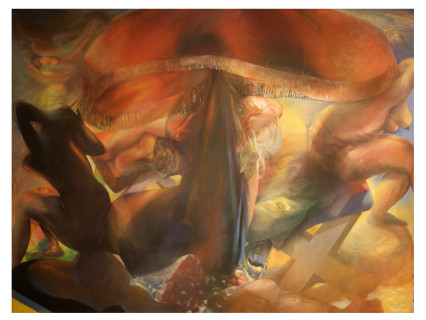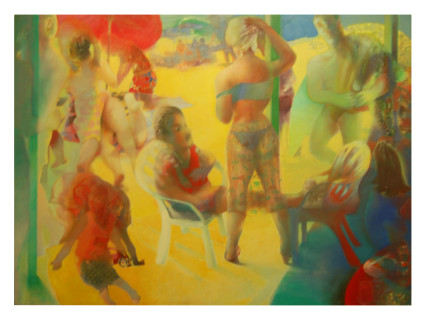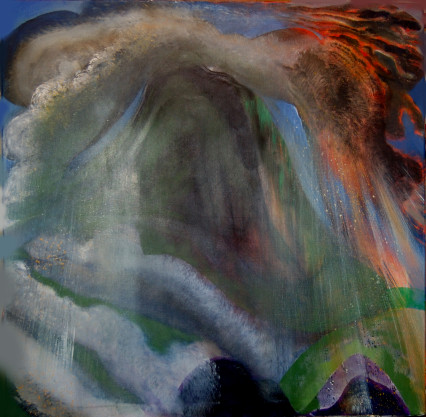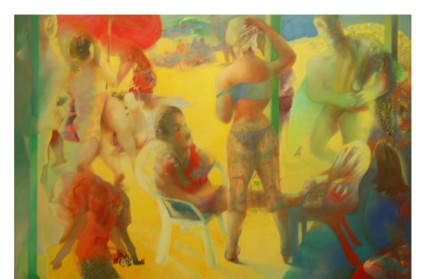Jonathan Glasbrook-Griffiths was at Llantarnam Grange Arts Centre in Cwmbran to review John Selway’s exhibition Trans Iberia.
Right from the very outset of his career the painter John Selway has often chosen to evolve an idea through a series of related artworks based around a particular theme. Whilst certain concepts have been resolved to his satisfaction over a relatively short interlude, other subjects have maintained their allure, to be revisited and revised with regularity. One such body of work is the subject of the exhibition, Trans Iberia, a selection of canvases and works on paper assembled from his various peregrinations around the Iberian Peninsula over a period of fifty or so years.

Perhaps somewhat surprisingly, given the frequency with which he has since returned to the region, Selway’s very first visit had more to do with expedience than conscientious planning. In 1962 he applied for and won the University of London’s prestigious Boise Travelling Scholarship. With New York having newly usurped Paris’ position as the centre of the art world he was encouraged by those around him to plunge head first into the city that famously never sleeps. Always his own man, after several years of study at the Royal College of Art in London Selway himself favored a less metropolitan milieu in which to continue his studies. Assisted by fellow R.C.A. alumnus Barrie Bates, who had relatives there, Selway had initially set his sights on the then little visited confederation of Yugoslavia, a plan that sadly had to be abandoned when Bates’ grandmother died unexpectedly not long before his departure. Hastily making new plans he instead decided to journey southwards by train via Paris and the Spanish interior to Lisbon and a territory that still continues to supply him with some of his most rewarding subject matter.

Displayed over two rooms, the smaller is given over to a succession of landscapes. Revealing the extent of his travels during that initial yearlong sojourn a series of small, semi abstract works on paper acknowledge his stays in both the Algarve in southern Portugal and Aragon in northeastern Spain. Occupying the remaining wall space are a number of more forceful swirling landscapes of Spanish subjects and in particular a grouping depicting La Rhune, a mountain located near the Atlantic coast at the western end of the Pyrenees on the border between the Spanish and French Basque countries. Originally roughed out in situ in the early spring of 2009, three small watercolour and gouache studies painted at various times of day and in various weather conditions provided Selway with a number of suitable reference points for the two larger oils, one a triptych, painted from memory back home in Abertillery. Eschewing the luminescent landscapes beloved of earlier adventurers such as Augustus John, J. D. Innes and those that followed along afterwards Selway instead invokes La Rhune’s reputation as a repository of Basque folklore and myth in lowering hues of grey and blue.

Bisected for the occasion by a temporary partition, Llantarnam’s main gallery continues to offer up additional variations on the theme of La Rhune, further landscapes in gouache and watercolour as well as several large figurative beach scenes. Occupying much of the gallery’s back wall the imperious oil, ‘Alpujarra Landscape with Birds, Early Morning 2013/14’ stands sentinel over a selection of similar vistas of the same area on the slopes of the southern Sierra Nevada in southwest Spain. More tightly worked than some of his more amorphous paintings of old these are works that repay close attention as they lay bare some of the less picturesque consequences of rural Spain’s ongoing reliance on the European Union’s largesse.
Notwithstanding his long-term enthusiasm for scrutinizing the landscape of Spain and Portugal, Selway’s other most enduring preoccupation has been with the uninhibited theatre of the beach and its environs. Encountering the easygoing ambiance of the continental seaside for the first time in Portugal two small pencil drawings, ‘Two Girls and Café Azul, Sétubal of 1962’ act as monochrome antecedents to the glowing yellow canvas ‘Café Azul (2001/2)’. Surmounted by jellyfish like parasols two flanking and similarly large paintings, ‘Andulusians I’ and ‘II’ both painted earlier this year combine a sense of both menace and eroticism with the shimmering colours of the Mediterranean littoral. Painted in oil using various techniques besides pure brushwork all three paintings exemplify Selway’s skill as a craftsman as well as his undimmed powers of imagination.
Comprising around fifty works Trans Iberia is sadly not quite as full a retrospective as it could have been due in part to the unavailability of certain works, in particular the series of paintings Selway completed following his Welsh Arts Council sponsored tour of Spain following around a traveling circus troupe in 1976. At nearly seventy-seven years of age John Selway reveals himself in Trans Iberia to be a painter at the very top of his game. Displayed in the intimate setting of Llantarnam Grange this is an exhibition deserving of an auditorium of national standing. Sadly in the topsy-turvy world of contemporary art so long as the majority of the nation’s cultural apparatchiks still remain in thrall to the emperor’s new clothes this is likely to remain nothing more than a pipe dream.
John Selway will be in conversation with David Alston, Arts Director, Cyngor Celfyddydau Cymru | Arts Council of Wales at 11.00am, Saturday May 2nd 2015
Exhibition until 9th May 2015
Recommended for you: An interview with John Selway.












